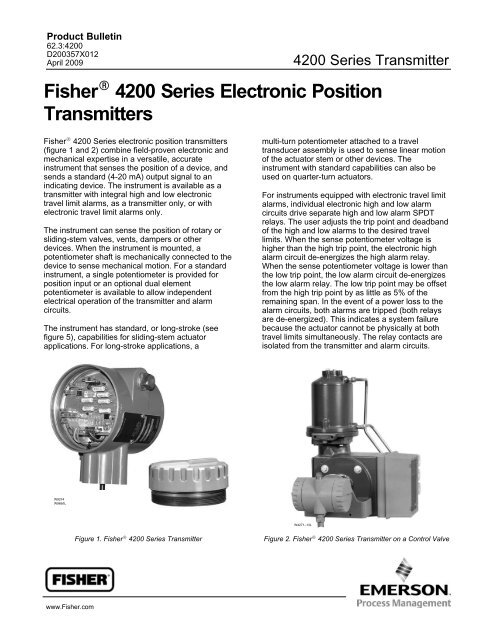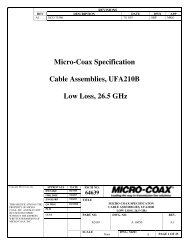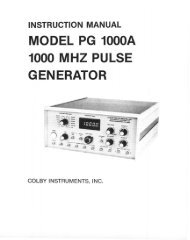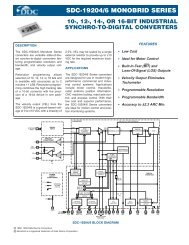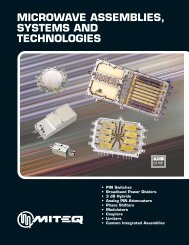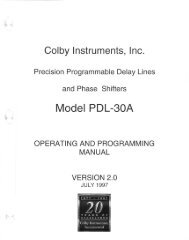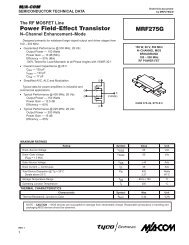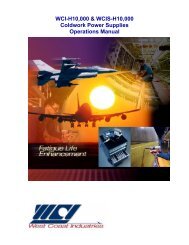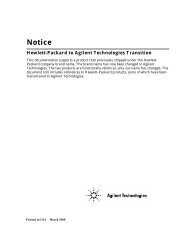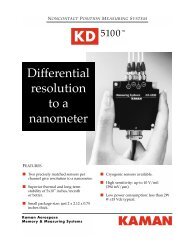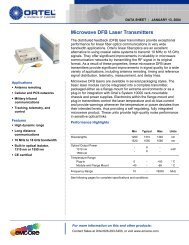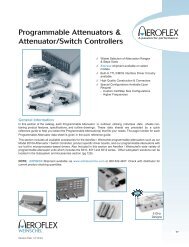Fisher 4200 Series Electronic Position Transmitters - Aptec Electronics
Fisher 4200 Series Electronic Position Transmitters - Aptec Electronics
Fisher 4200 Series Electronic Position Transmitters - Aptec Electronics
You also want an ePaper? Increase the reach of your titles
YUMPU automatically turns print PDFs into web optimized ePapers that Google loves.
Product Bulletin62.3:<strong>4200</strong>D200357X012April 2009<strong>4200</strong> <strong>Series</strong> Transmitter<strong>Fisher</strong> <strong>4200</strong> <strong>Series</strong> <strong>Electronic</strong> <strong>Position</strong><strong>Transmitters</strong><strong>Fisher</strong> <strong>4200</strong> <strong>Series</strong> electronic position transmitters(figure 1 and 2) combine field-proven electronic andmechanical expertise in a versatile, accurateinstrument that senses the position of a device, andsends a standard (4-20 mA) output signal to anindicating device. The instrument is available as atransmitter with integral high and low electronictravel limit alarms, as a transmitter only, or withelectronic travel limit alarms only.The instrument can sense the position of rotary orsliding-stem valves, vents, dampers or otherdevices. When the instrument is mounted, apotentiometer shaft is mechanically connected to thedevice to sense mechanical motion. For a standardinstrument, a single potentiometer is provided forposition input or an optional dual elementpotentiometer is available to allow independentelectrical operation of the transmitter and alarmcircuits.The instrument has standard, or long-stroke (seefigure 5), capabilities for sliding-stem actuatorapplications. For long-stroke applications, amulti-turn potentiometer attached to a traveltransducer assembly is used to sense linear motionof the actuator stem or other devices. Theinstrument with standard capabilities can also beused on quarter-turn actuators.For instruments equipped with electronic travel limitalarms, individual electronic high and low alarmcircuits drive separate high and low alarm SPDTrelays. The user adjusts the trip point and deadbandof the high and low alarms to the desired travellimits. When the sense potentiometer voltage ishigher than the high trip point, the electronic highalarm circuit de-energizes the high alarm relay.When the sense potentiometer voltage is lower thanthe low trip point, the low alarm circuit de-energizesthe low alarm relay. The low trip point may be offsetfrom the high trip point by as little as 5% of theremaining span. In the event of a power loss to thealarm circuits, both alarms are tripped (both relaysare de-energized). This indicates a system failurebecause the actuator cannot be physically at bothtravel limits simultaneously. The relay contacts areisolated from the transmitter and alarm circuits.W9274W966/ILW4271−1/ILFigure 1. <strong>Fisher</strong> <strong>4200</strong> <strong>Series</strong> TransmitterFigure 2. <strong>Fisher</strong> <strong>4200</strong> <strong>Series</strong> Transmitter on a Control ValveD200357X012www.<strong>Fisher</strong>.com
<strong>4200</strong> <strong>Series</strong> <strong>Transmitters</strong>Product Bulletin62.3:<strong>4200</strong>April 2009SpecificationsAvailable ConfigurationsSee table 1Input Signal Source Standard single potentiometer, or optional dual potentiometer is the source for thetransmitter and travel limit alarm circuit inputs.Refer to table 2 for zero and span limits.Transmitter Output SignalRange: 4-20 mA DC transmitter outputLoad Impedance: See figure 3.Output Current Limit: 30 mA DC maximumTravel Limit AlarmsNumber of Possible Alarms: Two or none. EachSPDT relay indicates limit and fault conditions asfollows:OperatingConditionTravel withinlimitsTravel beyondlimitsRelay CoilStateNC ContactStateNO ContactStateenergized open closedde-energized closed openPower loss de-energized closed openNC—Normally closed. Contacts are closed when relay is de-energizedNO—Normally open. Contacts are open when relay is de-energized.Power Supply RequirementsSee table 3Recommended Power Supply+24 volts DC nominalReference Accuracy±1% of output span. Includes combined effects ofhysteresis, linearity, and deadbandRepeatability: ±0.25% of spanOperating InfluencesAmbient Temperature: For a 56C (100F)change in normal operating conditions, maximumzero shift is ±0.5%, and the maximum span shift is±0.75% of spanPower Supply: Output signal changes less than±0.1% when operating terminal voltage variesbetween 11 and 30 volts DCElectromagnetic Compatibility for 4211 and 4221Meets EN 61326-1 (First Edition)Immunity—Industrial locations per Table 2 ofthe EN 61326-1 standard. Performance isshown in table 4 below.Emissions—Class AISM equipment rating: Group 1, Class ATravel Limit Alarm RelaysType: Two single-pole, double-throw relaysContacts: 1 Form C, silver-nickel alloy with goldoverlayService Rating: The relay rating is 5 amperes ateither 30 volts DC or 120 volts AC (resistive load).Life Expectancy: 100,000 operations at ratedload, or 50,000 operations at a typical in-rushcurrent of 10 amperes with a 120 volt AC lamp ormotor loadOperating ConditionsConditionAmbientTemperatureAmbientRelativeHumidityNormal andOperative Limits−40 to 71C(−40 to 160F)Transportationand StorageLimits−50 to 80C(−60 to 180F)NormalReference25C(77F)10 to 95% 10 to 95% 40%Construction MaterialsTransmitter Housing and Covers: AluminumAlloyO-Rings: NitrileMounting Hardware: SteelPipe Plug: Nickel coated steelCable: Nylon-coated stainless steel (long strokeonly)MountingThe instrument can mount on the actuator ofsliding-stem or rotary valves (refer to figure 5), orit can be used for other applications(continued)2
Product Bulletin62.3:<strong>4200</strong>April 2009Specifications (continued)Electrical ClassificationIntrinsic Safety, Explosion proof,Dust-Ignition proof,APPROVEDIntrinsic Safety, Explosion proof,Dust-Ignition proof, Non-IncendiveATEX Intrinsic Safety, Type n, DustRefer to tables 5, 6, and 7 for additionalinformation.Housing<strong>4200</strong> <strong>Series</strong> <strong>Transmitters</strong>NEMA 4X; CSA Enclosure 4X; IP66Approximate WeightTransmitter Without Mounting Bracket: 1.8 kg(4 pounds)OptionsLong-stroke applications: 12 or 24 inch travelNOTE: Specialized instrument terms are defined in ANSI/ISA Standard 51.1 − Process Instrument Terminology.Table 1. Available ConfigurationsTYPE NUMBER4210421142124215422042214222TRANSMITTERXX− − −XXX− − −1. See table 2 for zero and span limits.TRAVEL LIMITALARMSX− − −XXX− − −XTRAVELStandard StrokeUp to 105 mm (1)(Up to 4.125 Inches)XXXX− − −− − −− − −Long StrokeUp to 610 mm (1)(Up to 24 Inches)− − −− − −− − −− − −XXXDUALPOTENTIOMETER− − −− − −− − −X− − −− − −− − −Table 2. Zero and Span Limits (1)TYPENUMBERDEGREES OF POTENTIOMETERmm INCHESROTATIONLINKAGEZeroSpanCONNECTION (2) ZeroSpanZero Span Span<strong>Position</strong> Min. Max. <strong>Position</strong> Min. Max. <strong>Position</strong> Min. Max.42101 0 to 51 8 51 0 to 2 0.315 242110 to 90 15 9042122 0 to 105 17 105 0 to 4.125 0.670 4.1254215422012-inch Transducer 0 to 305 105 305 0 to 12 4.125 124221 0 to 884 150 884422224-inch Transducer 0 to 610 305 610 0 to 24 12 241. Zero position is the range of values over which the transmitter zero can be adjusted. Span is the range of shaft rotation or stem travel the transmitter span can be adjusted. Forexample, a zero position of 45 degrees and a span of 15 degrees means the transmitter output is 4 mA DC after 45 degrees of shaft rotation. The output then increases from 4 mA DC to20 mA DC as the shaft rotates from 45 to 60 degrees.2. Refer to figure 6 for location of connections.3
<strong>4200</strong> <strong>Series</strong> <strong>Transmitters</strong>Product Bulletin62.3:<strong>4200</strong>April 2009Table 3. Power Supply Requirements and Wiring ConnectionsTRANSMITTER TERMINALFIELD WIRING CONNECTIONSVOLTAGE (VDC)CURRENTREQUIRED (MA)Min Max Supply Wire (1) Signal Wire (2) Relay ReturnWire (3)Transmitter Only 11 30 20 max. X X − − −Transmitter withTravel Limit Alarms20 30 80 max. X X XTravel Limit Alarmswithout Transmitter20 30 50 max. X − − − XX indicates this connection required.1. Supply wire provides power supply positive connection for electronic circuits and relay coils (in instruments with travel limit alarms).2. Signal wire provides connection for device receiving 4 to 20 mA transmitter signal.3. Relay return wire provides separate return wire for relay coil currents.To reduce field wiring requirements from 4 to 3wires, the transmitter and alarm circuits share thepositive supply wire. A separate return wire isrequired to isolate relay coil currents from the 4-20mA transmitter signal.Features High Accuracy—A precision film-elementpotentiometer in the standard unit and a precisionmulti-turn wirewound potentiometer in thelong-stroke unit provide exceptional linearity bymatching the span of the sense element to theapplication. Application Versatility—This instrument maybe used with sliding-stem or rotary valves as well aswith other mechanical devices such as furnacedampers or louvers.LOAD IMPEDANCE (OHMS)100075065050025000 10 20 301124A6765/IL POWER SUPPLY VOLTAGE (VOLTS DC)OPERATINGREGIONMAXIMUM TRANSMITTERTERMINAL VOLTAGENOMINAL SUPPLYVOLTAGEMINIMUM TRANSMITTERTERMINAL VOLTAGE <strong>Electronic</strong> Travel Limit Alarms—To eliminatethe need for externally mounted mechanical limitswitches, instruments with travel limit alarmsincorporate comparator circuits that monitor thesense potentiometer voltage output. Adjustable Deadband—<strong>Electronic</strong> travel limitalarms have an adjustable deadband up to 10percent of the maximum span. Compact Design—The instrument, even withtravel limit alarms, uses little space when mounted,allowing room for additional devices.Figure 3. Transmitter Load Limitations Durable Construction—A rugged housing anda corrosion-resistant coating on the printed wiringboard help protect the instrument from harshenvironments. Simple Circuitry—A simple hybrid electronicdesign combines the best qualities of discretecomponents and integrated circuits for improvedreliability and performance.4
Product Bulletin62.3:<strong>4200</strong>April 2009<strong>4200</strong> <strong>Series</strong> <strong>Transmitters</strong>PRINTEDWIRINGBOARDRELAYNUMBER 1TERMINALBLOCKNUMBER 1FIELD PRINTEDWIRING BOARDTERMINALBLOCKNUMBER 3TERMINALBLOCKNUMBER 1W9275TERMINALBLOCKNUMBER 2W4675-1/ilRELAYNUMBER 2TRANSMITTER COMPARTMENTFIELD WIRING COMPARTMENTFigure 4. <strong>Fisher</strong> 4210 Transmitter Details Easy Maintenance—The simple design of thetransmitter and alarms allows easy maintenance.The high reliability of the instrument requiresminimum spare parts inventory. Moisture Resistant—The field wiringcompartment is isolated from the electroniccompartment. This protects the electronic circuitsfrom any moisture brought into the housing via thefield wiring ports. Field Reversible Action—The output is easilyreversed in the field simply by switching twopotentiometer leads on the printed wiring board. Electromagnetic Interference (EMI)Filters—Filters between the electronic compartmentand the field wiring compartment of the housing helpprovide protection against electromagneticinterference.ApplicationsStandard <strong>Position</strong> TransmitterSliding-Stem Valve—In typical valve applications,the transmitter is mounted on the actuator as shownin figure 1. Two linkage configurations sense up to51 mm (2 inches) or up to 105 mm (4.125 inches) ofstem travel. The linkages incorporate mechanicalgearing to linearize the transformation from linearmotion to rotational. To reduce the possibility ofphysical damage if the linkage should slip, thepotentiometer has no physical stops. Zero and spancan be adjusted as follows: Zero—Between 0 and 51 mm (2 inches) oftravel, or between 0 and 105 mm (4.125 inches) oftravel. Span—Between 9 mm (0.3 inch) minimumspan and 51 mm (2 inches) maximum span, orbetween 17 mm (0.6 inch) minimum span and 105mm (4.125 inches) maximum span.Rotary-Shaft Valve—In typical valve applications,the transmitter is mounted on the actuator as shownin figure 2. A coupling connects the hub of theactuator to the potentiometer shaft. To reduce thepossibility of physical damage if the coupling shouldslip, the potentiometer has no physical stops. Zeroand span can be adjusted as follows: Zero—Between 0 and 90 degrees of shaftrotation. Span—Between 15 and 90 degrees of shaftrotation.Other Devices—The transmitter is mounted suchthat the potentiometer shaft or linkage aligns with themotion of the device. The motion of the deviceshould not exceed the zero and span input signallimits in degrees of rotation.5
<strong>4200</strong> <strong>Series</strong> <strong>Transmitters</strong>Product Bulletin62.3:<strong>4200</strong>April 2009PORT1/2 NPT(2 PLACES) TRANSMITTERCOMPARTMENT102(4.00)FIELD WIRINGCOMPARTMENT159(6.25)102(4.00)CAP(2 PLACES)6 (0.25)DIA.35(1.38)67(2.62)END VIEW21(0.81)75(3.00)ALLOW 254 mm (10 INCHES)FOR MAINTENANCE (2 PLACES)67(2.62)POTENTIOMETERSHAFTSIDE VIEW51(2.00)5/16-18UNC13 DEEP(0.53)51(2.00)19A7968−EB1910−3*A / ILBOTTOM VIEWFigure 5. Dimensionsmm(INCH)Long-Stroke <strong>Position</strong> TransmitterLong-Stroke Sliding-Stem Valve—The transmitter ismounted on the actuator as shown in figure 5. Thetravel transducer assembly can sense from a 105mm (4.125 inch) minimum to a 610 mm (24 inch)maximum stem travel. The sensing element is amulti-turn potentiometer with physical stops. Twotravel transducer sizes are available for long strokeapplications. Zero—Between 0 and 305 mm (12 inches) forthe small transducer. Between 0 and 610 mm (24inches) for the large transducer. Span—Between 105 mm (4.125 inches)minimum and 305 mm (12 inches) maximum for thesmall transducer. Between 305 mm (12 inches)minimum and 610 mm (24 inches) maximum for thelarge transducer.6
Product Bulletin62.3:<strong>4200</strong>April 2009<strong>4200</strong> <strong>Series</strong> <strong>Transmitters</strong>Other Devices—The transmitter is mounted suchthat the travel transducer aligns with the motion ofthe device to allow straight retraction of the cable tothe transducer. The motion of the device should notexceed the zero and span limits in mm (inches).3. Valve body design.4. Other applicationsInstallationField wiring is inserted into one of the ports andconnected to the terminal blocks mounted on theprinted wiring board in the field wiring compartment.The instrument with transmitter circuits and travellimit alarms, and the instrument with alarms only (notransmitter circuits), use terminal blocks numbered1, 2, and 3 (see figure 4) on the printed wiring board.These terminal blocks are accessible when the fieldwiring compartment cover is removed. Theinstrument with transmitter circuits only (no alarms)uses a barrier strip mounted in the field wiringcompartment without the printed wiring board.Dimensions of the transmitter housing are shown infigure 5. Mounting dimensions are shown in figure 6.Ordering InformationWhen ordering, specify:1. Transmitter type number.2. Actuator type, size, and length of stroke.(Note: For <strong>Fisher</strong> 585CLS <strong>Series</strong> actuators, specifyyoke boss and cylinder size.)NoteContact your Emerson ProcessManagement sales office forassistance in determining the type andstyle of linkage and mountinghardware required for the application.NoteNeither Emerson, Emerson ProcessManagement, nor any of their affiliatedentities assumes responsibility for theselection, use, or maintenance of anyproduct. Responsibility for theselection, use, and maintenance of anyproduct remains with the purchaserand end-user.7
<strong>4200</strong> <strong>Series</strong> <strong>Transmitters</strong>Product Bulletin62.3:<strong>4200</strong>April 200948(1.88)108(4.25)86(3.40)271(10.69)204(8.00)ACTUATORHOUSING51(2.00)CONNECTIONNUMBER 1CONNECTIONNUMBER 2TYPICAL MOUNTING BRACKET DIMENSIONSFOR SLIDING-STEM ACTUATORSTYPICAL MOUNTING BRACKET DIMENSIONSFOR ROTARY-SHAFT ACTUATORSFISHER <strong>4200</strong> SERIES TRANSMITTER MOUNTING10(0.38)204(8)1111(4.38)GE16563-A / ILMOUNTING BRACKET DIMENSIONS FORFISHER 585CLS ACTUATORSWITH A 152 mm (6-INCH) CHANNELNOTE:1 FOR OTHER SIZES OF 585CLS ACTUATORS, THE MOUNTING PLATELENGTH WILL CHANGE DEPENDING ON THE CHANNEL WIDTH.FISHER <strong>4200</strong> SERIES TRANSMITTER (LONG-STROKE) MOUNTINGFigure 6. Mounting Dimensions8
Product Bulletin62.3:<strong>4200</strong>April 2009<strong>4200</strong> <strong>Series</strong> <strong>Transmitters</strong>Table 4. <strong>Fisher</strong> 4211 and 4221 <strong>Electronic</strong> <strong>Position</strong> Transmitter EMC Summary Results—ImmunityPORTPHENOMENONBASICPERFORMANCETEST LEVELSTANDARDCRITERIA (1)Electrostatic Discharge (ESD) IEC 61000-4-24 kV contact8 kV airAEnclosure Radiated EM field IEC 61000-4-380 to 1000 MHz @ 10V/m with 1 kHz AM at 80%1400 to 2000 MHz @ 3V/m with 1 kHz AM at 80%A2000 to 2700 MHz @ 1V/m with 1 kHz AM at 80%Rated power frequency magneticfieldIEC 61000-4-8 60 A/m at 50 Hz ABurst (fast transients) IEC 61000-4-4 1 kV ASurge IEC 61000-4-5 1 kV (line to ground only, each) BI/O signal/control150 kHz to 80 MHz at 3 VrmsConducted RF IEC 61000-4-6A1 kHz AM at 80%Specification limit = ±1% of span1. A = No degradation during testing. B = Temporary degradation during testing, but is self-recovering.Table 5. <strong>Fisher</strong> <strong>4200</strong> <strong>Series</strong> <strong>Electronic</strong> <strong>Position</strong> Transmitter Hazardous Area Classifications—CSA (Canada)CERTIFICATIONBODYCSATYPE CERTIFICATION OBTAINED ENTITY RATING4211, 42214210, 4211,4212, 4215,4220, 4221,42224210, 4211,4212, 4215,4220, 4221,4222(Intrinsic Safety)Class/DivisionClass I,II,III Division 1 GP A,B,C,D,E,F,Gper drawing GE16020(Explosion Proof)ZoneEx d IIC T5Class/DivisionClass I, Division 1 GP B,C,D T5U i = 30 VDCI i = 150 mAP i = 1.0 WC i = 5 nFL i = 0 mHTEMPERATURECODET4(T amb 71°C)ENCLOSURERATING4X− − − T5 (T amb 71°C) 4XClass II Division 1 GP E,F,G T5 − − − T5 (T amb 71°C) 4XTable 6. <strong>Fisher</strong> <strong>4200</strong> <strong>Series</strong> <strong>Electronic</strong> <strong>Position</strong> Transmitter Hazardous Area Classifications—FM (United States)CERTIFICATIONBODYFMTYPE CERTIFICATION OBTAINED ENTITY RATING4211, 42214210, 4211,4212, 4215,4220, 4221,42224211, 42214210, 4211,4212, 4215,4220, 4221,4222(Intrinsic Safety)Class/DivisionClass I,II,III Division 1 GP A,B,C,D,E,F,Gper drawing GE16019(Explosion Proof)ZoneClass I Zone 1 AEx d IIC T5Class/DivisionClass I, Division 1 GP A,B,C,D T5Class I Division 2 GP A,B,C,D T5Class II Division 2 GP F,G T5V max = 30 VDCI max = 150 mAP i =1.0 WC i = 5 nFL i = 0 mHTEMPERATURECODET4 (T amb 71°C)ENCLOSURERATING4X− − − T5 (T amb 71°C) 4X− − − T5 (T amb 71°C) 4XClass II Division 1 GP E,F,G T5 − − − T5 (T amb 71°C) 4X9
<strong>4200</strong> <strong>Series</strong> <strong>Transmitters</strong>Product Bulletin62.3:<strong>4200</strong>April 2009Table 7. <strong>Fisher</strong> 4211 and 4221 <strong>Electronic</strong> <strong>Position</strong> Transmitter Hazardous Area Classifications—ATEXCERTIFICATE TYPE CERTIFICATION OBTAINED ENTITY RATINGII 1 GDTEMPERATURECODEENCLOSURERATINGATEX4211, 4221GasEx ia IIC T4/T5—Intrinsic SafetyDustEx tD A20 IP66 T81°C (T amb 71°C)Ex tD A20 IP66 T50°C (T amb 40°C)U i = 30 VDCI i = 150 mAP i = 1.0 WC i = 5 nFL i = 0 mHT4 (T amb 71°C)T5 (T amb 40°C)− − −IP66II 3 GD4211, 4221GasEx nL IIC T4—Type nDustEx tD A22 IP66 T81°C (T amb 71°C)− − −T4 (T amb 71°C)− − −IP6610
Product Bulletin62.3:<strong>4200</strong>April 2009<strong>4200</strong> <strong>Series</strong> <strong>Transmitters</strong>11
<strong>4200</strong> <strong>Series</strong> <strong>Transmitters</strong>Product Bulletin62.3:<strong>4200</strong>April 2009<strong>Fisher</strong> is a mark owned by one of the companies in the Emerson Process Management business division of Emerson Electric Co. EmersonProcess Management, Emerson, and the Emerson logo are trademarks and service marks of Emerson Electric Co. All other marks are the propertyof their respective owners.The contents of this publication are presented for informational purposes only, and while every effort has been made to ensure their accuracy, theyare not to be construed as warranties or guarantees, express or implied, regarding the products or services described herein or their use orapplicability. All sales are governed by our terms and conditions, which are available upon request. We reserve the right to modify or improve thedesigns or specifications of such products at any time without notice. Neither Emerson, Emerson Process Management, nor any of their affiliatedentities assumes responsibility for the selection, use or maintenance of any product. Responsibility for proper selection, use, and maintenance ofany product remains solely with the purchaser and end-user.Emerson Process ManagementMarshalltown, Iowa 50158 USASorocaba, 18087 BrazilChatham, Kent ME4 4QZ UKDubai, United Arab EmiratesSingapore 128461 Singaporewww.<strong>Fisher</strong>.com<strong>Fisher</strong> 12 Controls International LLC 1985, 2009; All Rights Reserved


